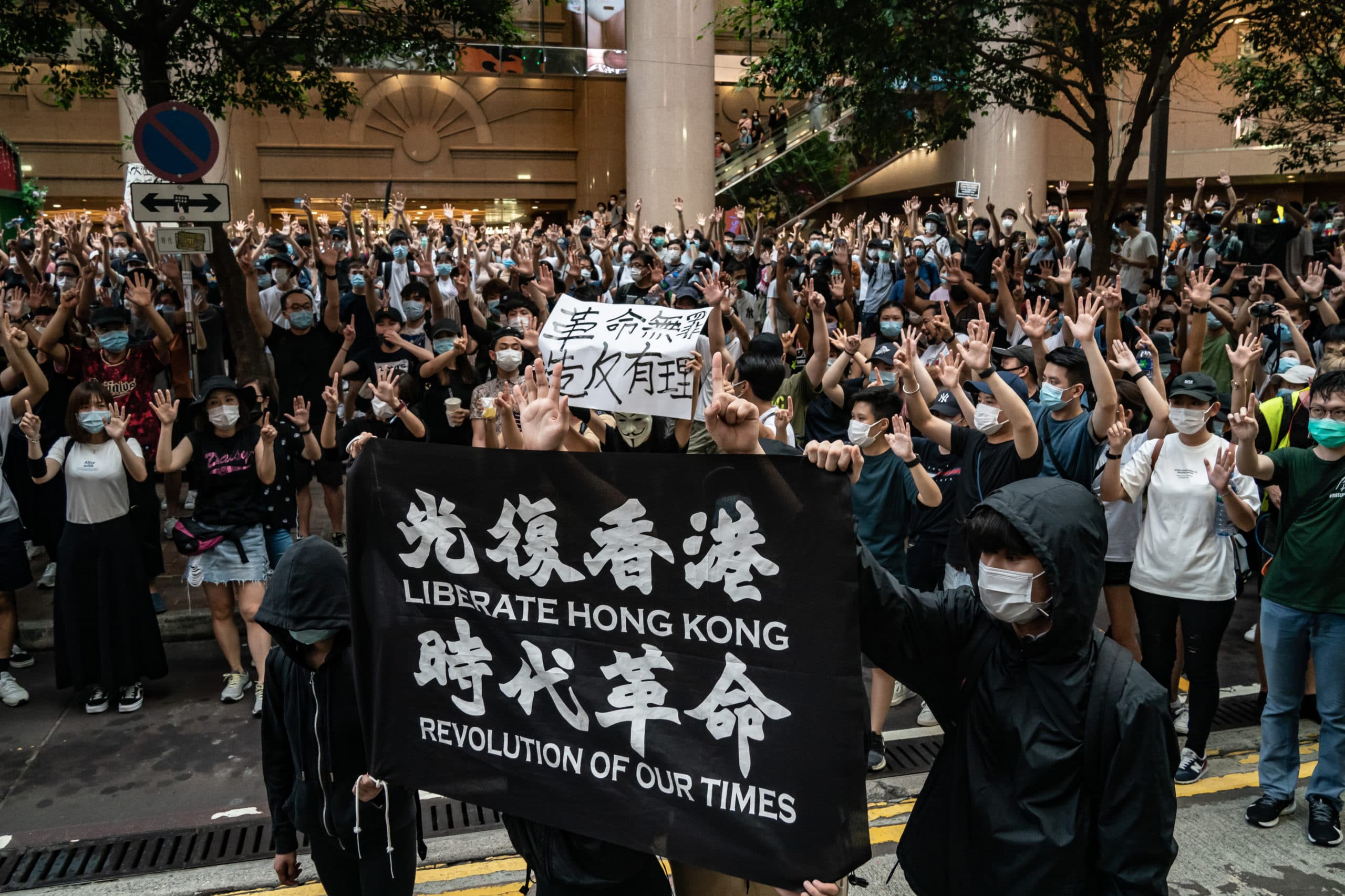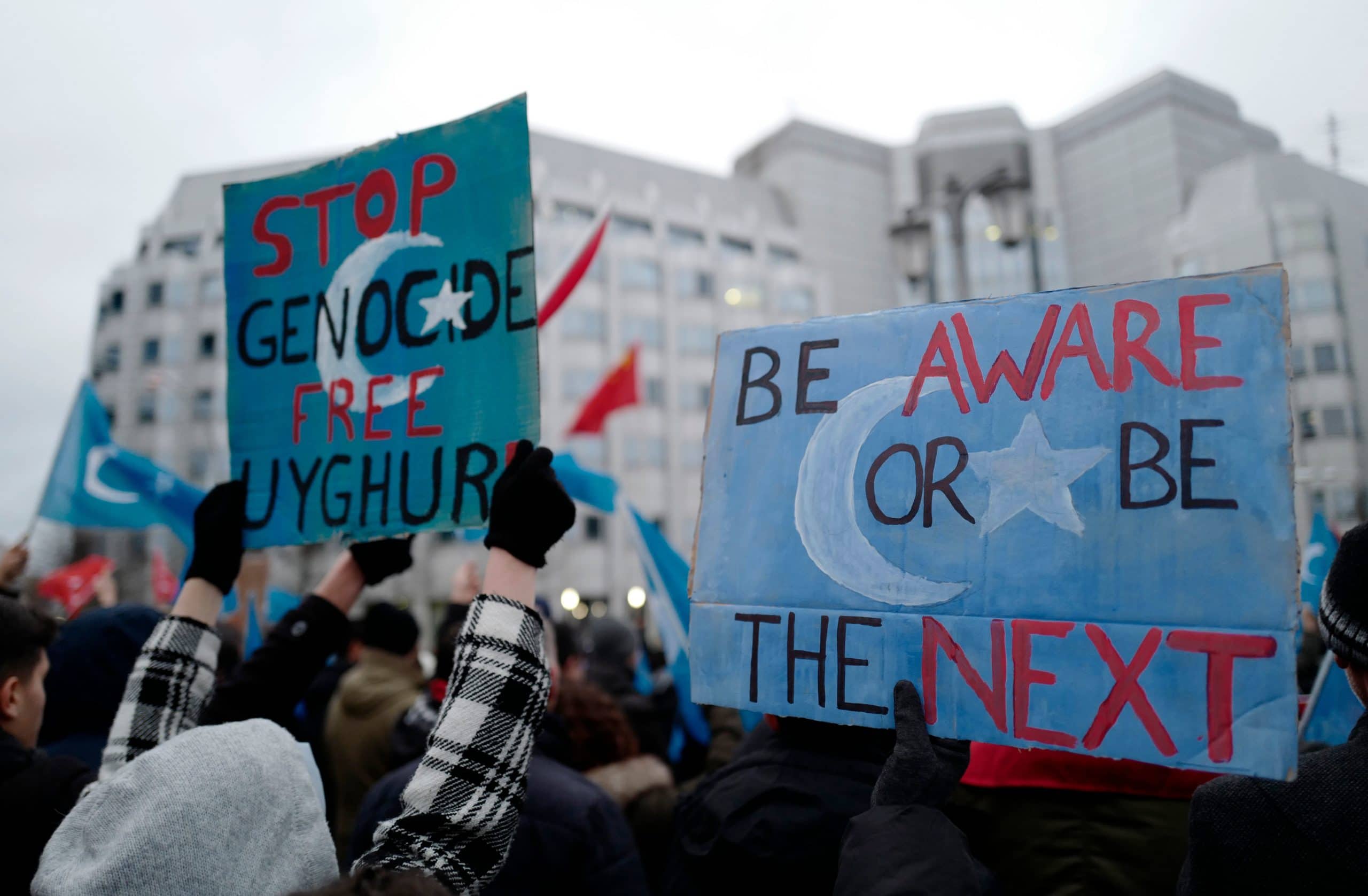January 14, 2021 | From Trump to Biden Monograph
China
January 14, 2021 | From Trump to Biden Monograph
China
Current Policy
The Trump administration’s 2017 National Security Strategy declared that “China and Russia want to shape a world antithetical to U.S. values and interests.”1 This came in sharp contrast to the previous administration, which in 2015 asserted that “the scope of [U.S.] cooperation with China is unprecedented.”2
In the first half of its term, the Trump administration confronted China mainly on trade issues, leading the administration to impose tariffs on $250 billion of Chinese imports. In January 2020, the United States and China reached a “Phase One” trade deal,3 lifting some of the tariffs and prompting talk of a new calm in the U.S.-China relationship.4
That truce was shattered by COVID-19. Trump initially complimented China’s handling of the virus but later changed his tone.5 He began referring to COVID-19 as the “China virus” and accused Beijing of colluding with the World Health Organization (WHO) to obscure China’s misconduct.6 In April 2020, the Trump administration activated the Defense Production Act in response to China’s preclusive purchasing of personal protective equipment. The administration announced in July it would withdraw from the WHO.
The tensions that grew out of the pandemic led to aggressive Trump administration moves in other arenas, such as technology, human rights, and military affairs. The administration issued a series of executive orders intended to shore up industrial supply chains as well as informational vulnerabilities. These orders placed restrictions on products from Chinese technology firms, including Huawei in telecommunications and DJI in unmanned aerial vehicles.
In May 2020, the administration issued an executive order blocking Chinese researchers with ties to the security apparatus from using F or J student visas to enter the United States.7 An order in August prohibited downloads of WeChat, a messaging, social media, and electronic payment application that is owned by China’s Tencent Holdings and captures large quantities of information; another in September outlined ambitions to remediate dependencies on China for critical materials.8 One week after the 2020 elections, yet another order banned Americans from investing in firms connected to the Chinese military.9
All these measures reflect a growing concern over China’s military-civil fusion program – Beijing’s strategy and institutional apparatus that wields Chinese commercial and civilian positioning and resources, at home and abroad, for coercive ends.10 Beginning in June 2020, the Department of Defense produced a list of 31 Chinese military-linked companies operating in the United States, its response to a long-unaddressed tasking from the 1999 National Defense Authorization Act.11
The Trump administration also issued sanctions in response to Beijing’s human rights violations at home and aggressive posture abroad. In July 2020, the Treasury Department sanctioned the Xinjiang Production and Construction Corps for its connections to mass detention and forced labor in Xinjiang.12 In August, the State and Commerce departments levied sanctions against China Communications Construction Company for its role in China’s provocative South China Sea island building campaign.13
Finally, the administration made a concerted effort to vocalize its China policy to domestic and global audiences. In June and July 2019, the national security advisor, FBI director, secretary of state, and attorney general delivered a series of speeches describing the threat posed by the Chinese Communist Party (CCP). “If we don’t act now, ultimately the CCP will erode our freedoms and subvert the rules-based order that our societies have worked so hard to build,” Secretary of State Pompeo said.14
Assessment
The Trump administration’s recognition of the CCP threat was necessary and long overdue. But the approach was still reactive and defensive – and too often unilateral. The United States needs an effective strategy to contest Beijing’s influence across all competitive domains. Such a strategy must account for China’s military-civil fusion strategy, standard-setting ambitions, and weaponization of international systems and organizations.15 This strategy must be multilateral, incorporating allies and partners as well as the private sector.
Beijing is currently pursuing a global offensive for information dominance. Technology firms such as Huawei and ByteDance provide Beijing with valuable tools, including the ability to aggregate data and shape narratives. Beijing also competes in less flashy segments of the technological contest: The CCP prioritizes technical standards, physical infrastructures and manufacturing, and supply chain nodes. These constitute the software and hardware of the emerging advanced technological landscape.16
Too often, the administration appeared to be chasing Hydra heads. A better approach would be to define the critical sectors of information competition and compete holistically. Simply ripping and replacing Chinese-made telecommunications equipment or imposing tariffs on Beijing for anti-market policies has little effect in a contest for global supremacy. The United States must provide positive, affirmative alternatives to Chinese standards, infrastructures, and critical supply chains.
To its credit, the Trump administration understood the U.S.-China competition as, at least in part, a struggle over global political norms. Beijing engages in human rights atrocities domestically. It also seeks to proliferate its authoritarian model globally. The CCP’s imposition of the National Security Law in Hong Kong and ongoing genocide of the Uyghur minority in Xinjiang underline as much.17

Demonstrators in Hong Kong protest against Beijing’s new National Security Law on July 1, 2020, the 23rd anniversary of the territory’s handover to China. (Photo by Anthony Kwan/Getty Images)
Still, the Trump administration was passive in terms of setting global norms. Indeed, Trump openly admired Chinese leader Xi Jinping’s untrammeled authority. This left Congress to take the lead by passing the Hong Kong Human Rights and Democracy Act and the Uyghur Human Rights Policy Act with overwhelming bipartisan support. In foreign policy, however, there is no substitute for presidential leadership. The United States can halt China’s authoritarian offensive only if Washington defines the playing field, targets China’s sensitivities, and attends in advance to the vulnerable targets of Beijing’s assaults.
While the Trump administration was able to elevate the China challenge among some of its allies, it failed to inspire a systemic and coordinated effort on the part of its allies, its partners, and the private sector. Washington has recognized that China has bent institutions of global governance to serve its narrow interests, including the WHO and various standard-setting bodies. But it is not enough simply to withdraw from those institutions (just as it is not enough to ban Huawei or TikTok). The United States has to play a leading role in reforming existing organizations while still possible and, where necessary, build new ones free of China’s co-optation. Washington must do so multilaterally, in conjunction with other global stakeholders. It must also incorporate the private sector into decision making – and structures of accountability – to shape a world in which China’s global influence is diminished.
With Trump’s help, the pandemic elicited greater pushback against Beijing’s global presence. Yet the CCP’s confidence and aggressiveness have only grown. And the pandemic has accelerated the flow of global resources – including capital and data – to China.
Recommendations
U.S. policy should be built upon a bipartisan consensus that Beijing’s repressive regime is proliferating authoritarianism abroad, intends to undermine U.S. leadership, and seeks to shape international norms, standards, supply chains, and institutions to serve its interests. The United States must not lose sight of today’s great power competition. Beijing is not a responsible stakeholder. Washington must formulate a competitive strategy tailored to countering Beijing’s approach.
- Compete to define emerging technical standards, especially in key information domains such as modern logistics and the regulation of cross-border data flows. China intends to set the rules for the future. The United States must respond with dedicated multilateral efforts in UN-linked bodies such as the International Organization for Standardization and the International Telecommunication Union and in industry associations such as the Institute of Electrical and Electronics Engineers. U.S. government research and development (R&D) funding should shift from basic research and toward later-stage, applied technology efforts. R&D funding and government research institutes, such as the Defense Advanced Research Projects Agency and the National Science Foundation, should be enlisted in the race to define technical standards globally.
- Defend or replace international organizations at risk of being co-opted by Beijing, while activating alternatives. Beijing has co-opted or inserted its own advocates into a wide range of international organizations. The challenges these organizations pose must be analyzed and prioritized. For example, an overhaul of the World Trade Organization should be a priority. Beijing’s 2001 accession to the body enabled its global offensive. An alternative or remodeled institution, formed with trusted allies and partners as well as the private sector, would not only reassert a rules-based global trade regime but also help create a system defined by multinational companies in a way that balances asymmetric exposures to, and dependencies on, the CCP.
- Fund trusted supply chains with allies and partners. Beijing’s military-civil fusion strategy seizes critical chokepoints within global supply chains. These positions offer direct economic returns and access to advanced technology. In times of crisis, as COVID-19 revealed, these positions also deliver coercive leverage. Washington should invest in physical infrastructure and production – with help from adjustments to the tax code and other incentives for public-private partnership – to protect against Beijing’s manufacturing leverage. Washington should prioritize new infrastructure systems and relevant supply chains (such as 5G base stations, data centers, and critical raw materials such as rare earth elements).

Demonstrators take part in a protest outside the Chinese Embassy in Berlin on December 27, 2019, to call attention to China’s mistreatment of members of the Uyghur community in western China. (Photo by John MacDougall/AFP via Getty Images)
- Highlight and respond to China’s human rights abuses. The CCP is conducting a genocide in Xinjiang. The CCP has stripped Hong Kong of its democracy and autonomy. The White House and Congress must respond to these abuses not just with clear statements of principle or threats of sanctions, but also with measures that impose a greater cost on the regime, including prosecution of criminal actions related to, and seizures of goods produced by, forced labor. The United States should also mobilize coordinated action with allies across the globe.
- Target China’s military and diplomatic sensitivities. U.S. military and diplomatic strategy should activate Beijing’s sensitivities – both for tactical advantage and, strategically, to shape China’s resource allocations. For example, the United States should respond to Beijing’s violation of the Sino-British Joint Declaration in Hong Kong by recognizing Taiwan. The Department of Defense should develop new operational concepts that demonstrate, for example, a capacity to penetrate the Chinese military’s anti-access posture.18 Diplomatic and military positioning should be signaled in a consistent and competitive fashion to guarantee that China’s Communist leaders understand the costs of their actions and the depth of U.S. resolve.
